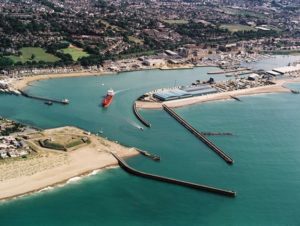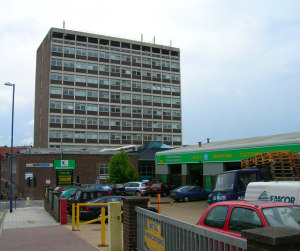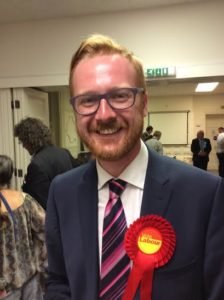It can be perilous making predictions, particularly about the future. So here goes, a few priceless – that is, free – glimpses into the year ahead and what 2017 holds for Brighton and Hove.
Money will be a big talking point, not least the introduction of the new 12-sided pound coin in March, relatively shortly after our plastic fivers.
The harder-to-forge coins are being minted because so many fake £1 coins were in circulation. A fair few came from the Netherlands in a scam linked to Coin Co International (CCI), the cash collection company that went bust owing Brighton and Hove City Council more than £3 million.
A hefty slice of that cash came from parking machines around Brighton and Hove. New machines are coming. Some will take the new coins. Some will allow contactless payment by debit card.
More people will switch to paying by phone despite the extra charge. Phone payments are cheaper for the council to administer than cash. Imagine how many more people would switch if there was an incentivising discount – even just a modest one!
Expect more calls for park and ride and possibly even for proper coach parking, for these are perennial problems – rather like the pollution along roads such as North Street, London Road and Lewes Road. Park and ride is opposed by some but, combined with other measures and in purely practical terms, it would mean fewer vehicles along those currently choked roads. Lip service is probable but progress unlikely.

Money will also be at the centre of the wrangling between now and the council budget meeting on Thursday 23 February when the coming year’s council tax will be set.
All the hullabaloo will soon be largely forgotten by almost everyone outside council-land, although some of the cuts will be felt.
A council tax rise of 5 per cent is in prospect – just over £80 a year for a band D property – unless, of course, you’re among the 34,000 students who enjoy an exemption. Pressure is building for students or landlords to cough up. In the end, that will mean the students pay – either directly or through higher rents.
The government is reducing the amount that it gives to councils but doesn’t make it easy for them to raise money by other means, such as council tax rises.
This means that costs have to be managed – and that often means that services have to be cut. The youth service is in the firing line this year along with parks and open spaces.
The council may be faced with a solid campaign as the charities and community groups that do so much of the legwork – under contract – mobilise support.
The £450,000 a year paid by the council to the youth service charities is matched by money that they raise from other sources so that each council pound spent goes further.

In addition, the youth workers are effectively engaged in preventive work. If successful, young people will be constructively occupied.
Without them, young people’s health and relationships may suffer or they may end up in trouble. The cost to the public purse could well be greater than the savings on the youth service contract.
Part of the council tax rise is a sticking plaster solution to the adult social care crisis. Costs are rising in places like care homes, in part because of the national living wage. Some homes may fold.
The quality of care will also remain in focus – and inspections will continue to find poor standards in too many homes. Relatively few are outstanding.
All of this is happening against the backdrop of Brexit – Britain leaving the European Union. The Prime Minister Theresa May has said that she will trigger the exit process by the end of March.
Plenty of people in Brighton and Hove want to know what sort of relationship Britain will have with the EU, not least because jobs are riding on it.
Among those keen to learn more are the executives running the universities and language schools and businesses big and small. American Express and Shoreham Port are among the organisations that benefit from free movement of people, goods, services and capital. Likewise, Gatwick Airport, just up the road.
Plenty of smaller firms, self-employed people and students will also be affected by the way things shake out. Few benefit from the current uncertainty.

One thing is for sure – Mrs May can’t keep her cards close to her chest forever. She is going to have to say what her aims are. It would be better for her and for the rest of us if she set clear goals, underpinned with clear reasoning. Her present position is unsustainable.
Forward-looking businesses are also bracing themselves for the rating revaluation which comes into force from the start of April.
And the universities – Sussex and Brighton – are responding to local pressure on housing. The problems built up over years and won’t be solved overnight.
But more student flats will be built and more will be given planning permission before the year is out. The pressure on family homes in places like Moulsecoomb and Bevendean will continue.
Both Sussex and Brighton have relatively new vice-chancellors. There may no better time to explore whether we might be better served by having one university rather than two.
They are distinct and they do co-operate in some areas already. The medical school is one example. The British Science Festival – being jointly hosted in September – is another.
But despite the retreat from Hastings, Brighton remains more like a university of Sussex – and Sussex is more like a university of Brighton.
The proposed merger of City College and Northbrook – smaller institutions – show what is possible in the further education sector.

Still with education, progress will be made on adapting the West Blatchington site in Hove for the King’s School, the Church of England secondary school that is currently based in Portslade.
But efforts to provide a new secondary on the other side of the city have proved more challenging. There are few suitable sites.
Parents continue to want to know where the new school, sponsored by Brighton University, will be. If it is to open on time in September next year, a decision will be needed soon.
A building owned by City College, in Pelham Street, and a site in the grounds of Brighton General Hospital are being looked at.
The council may try to muddle through, adding capacity where possible to existing schools. Rumblings from the existing heads are adding to the pressure to do this. Some of them have spare places despite raising standards. And financially it would be the cheaper option in the short term.
Brighton College will benefit from any inertia or lack of clarity. It will continue to be feted nationally while being ignored locally by those who could learn from its transformation over the past 15 to 20 years. Its facilities are much better as are its results. Money, of course, played a part in the public school’s changing fortunes but it was far from the only key ingredient.
A few hundred yards from Brighton College, another local institution is having a harder time of it. The Royal Sussex County Hospital has been in crisis although regulators have praised frontline clinical staff.

The hospital trust will have a new board as Western Sussex Hospitals takes the first step towards a potential merger. There are fears among some that the team running hospitals in Worthing and Chichester risk becoming overstretched.
After all, the Brighton trust is a big enough job in itself – and, despite a dedicated team, it will end the financial year in March about £60 million in the red. As with the council, a crucial factor is the national funding picture.
The key members of the new board do have a good track record, though, and will be keen to persuade one of the brightest workforces in Brighton and Hove to step up to the plate.
At the same there will be increasing signs of the £485 modernisation of the Royal Sussex gathering pace. The helicopter pad on the roof of the Thomas Kemp Tower will be one of the most visible signs. The first patients could arrive by the helipad by the end of the year.
In Hove the Montefiore Hospital, run by Spire, is preparing to expand with an extension in Montefiore Road – if approved – adding an emergency department and more beds.
Doctors’ surgeries remain under pressure – six have closed in Brighton and Hove over the past two years. With retirements looming and financial pressures showing no sign of abating, others may follow.
Patients are being encouraged to use their local chemists but they too are under pressure. And while the likes of Kamson have proved to be something of a success story, some smaller chemists may struggle under the latest less generous funding settlement from the Department of Health.
Health and Wellbeing Board chairman Dan Yates warned that we could see the first pharmacy close in the coming year as the new funding regime bites.

The challenges facing the Sussex Beacon will come to a head. If the Beacon, which is a charity, is unable to secure extra funds from the NHS for its work, it faces stark choices. But being a charity, it attracts other funding too and helps NHS cash go further.
It may be a case of rethinking the way that it operates or having to close some or all of its services. The trustees will not want an unsustainable future for the organisation which operates with a relatively modest budget.
In the meantime, thousands of runners will step out next month for the annual half marathon – the charity’s biggest fundraiser of the year.
Brighton and Hove’s other favourite charities – the Martlets, Brighton Housing Trust (BHT) and Rockinghorse – will continue to raise money and awareness. Rockinghorse is 50 this year and has planned ahead to ensure that it’s a year to remember, with some ambitious fundraising targets.
Expect to see even more people cycling around the area in the summer with the arrival of Brighton and Hove’s version of Boris bikes.
Don’t expect to see the seafront mix improve though, with cyclists still banned from much of the prom. In Madrid, the riverside path has a sociable mix of cyclists, skaters and people on foot, with regular reminders that pedestrians have priority. Maybe everyone’s just that little more relaxed there.
They used to say: “Let the train take the strain.” But taking the train has been a stressful way to travel for the past year, with two unions calling a series of strikes – the RMT, representing guards, and Aslef, representing drivers.

Few passengers show any signs of having any faith in train operator Govia or the government resolving the dispute. Some blame the unions although a recent survey suggests more think the bosses or ministers and officials are at fault.
The compromise at Scotrail, to end a similar dispute, showed that a resolution is possible. While some people want the unions defeated, if they succeed it will have happened at the expense of paying passengers and at a high price.
The secrecy surrounding the Govia contract and its performance clauses have served only to undermine faith in officials and ministers. The new contract, reclassifying guards or conductors as on-board supervisors, was imposed.
The strikes are a reminder of the value of winning over hearts and minds when bringing in change. Govia hasn’t managed to take its workforce with it – hard but crucial in a modern, liberal, civilised and democratic society. As a result it’s left quite a few passengers stranded too.
The fiasco surrounding the modernisation of London Bridge is fresh in many people’s minds. Some say the franchise is too big. Or more competition would be better. Calls for renationalisation will go unheeded but Govia may yet lose the Southern contract.
More Labour pains – within the Labour Party – will be felt locally as well as nationally. The tensions between supporters and critics of Jeremy Corbyn will rumble on throughout the spring.
Two events could prove crucial to his continuing leadership, The first is the contest to run the Unite union, with Corbyn backer Len McCluskey facing a challenge from Gerard Coyne. Then, in May, local election results – especially in Scotland and Wales – will be scrutinised closely.
Rumours persist of a by-election in Brighton and Hove before the year is out. Labour held East Brighton in a by-election last summer. But the party is enduring the pain of reorganising on the ground locally and not everyone is behaving in a comradely manner. The Conservatives are not sitting idly on the sidelines watching with glee but are analysing the opportunities as they aim to win back the council in 2019 despite the demographic challenges.

The council will announce the completion of the sale of its old headquarters, King’s House, but work on converting the site to housing won’t start in 2017. Nor will work start on the King Alfred site – and probably not even in 2018.
Another Hove landmark, the Lansdowne Place Hotel, formerly the Dudley, will be sold. Plans to turn the hotel into housing have been agreed but look unlikely to get under way in the coming year.
Work will, however, start on new homes and student flats in Circus Street, Brighton, and plans to develop the Preston Barracks site will be decided.
Questions will be asked about another barracks site – at Highcroft – where land at the back could be used to give Stanford Infant School children more space to play, funded by more much-needed housing.
The bulldozers will finally level Anston House, opposite Preston Park. And the council and housing association Hyde will reveal where they want to build the first of 1,000 living wage homes. Despite the broad political consensus that the city needs more low-cost homes, it won’t all be plain sailing. The devil will be in the detail.
Hyde, though, has shown patience and determination in the past. It has consistently delivered, unlike many, and is tacking and trimming so that its plans for the Sackville Hotel site win sufficient support and its other schemes come to fruit.
Meanwhile, more homes will go up at Brighton Marina even if they are likely to attract a wealthier sort of buyer.
And despite everything, housing demand will continue to outstrip supply, especially homes that local people can afford. Family homes will keep being lost in places like Moulsecoomb and Bevendean as councillors wrestle with the growing number of shared homes – also known as HMOs. Any controls will take a while to introduce as some complain that the area is becoming an extension of the university campuses.
At the other end of Brighton and Hove, more signs will appear that Portslade is becoming gentrified. Or to put it another way, people who can’t afford places like Poets Corner will go west. It’s evolution, not revolution though.

The truly poor, the street homeless, will still be trying to find shelter in places like shop doorways despite the best efforts of many good people. Groups like BHT and the churches working together to provide a winter night shelter will literally keep saving lives.
The churches face their own challenges. The Church of England, for example, has drawn heavily on its financial reserves in recent years. And like family doctors, a disproportionate number of clergy are approaching retirement age. The Diocese of Chichester will cast its net for the next generation. Meanwhile, vacancies at All Saints, Hove, and St Andrew’s, Moulsecoomb, for example, remain unfilled.
The cost of keeping churches open and properly maintained remains a struggle. There are signs of a more outward-looking leadership tackling these problems in the diocese. They may even start to learn from the revival of St Peter’s in Brighton where the scaffolding will start coming down soon as the £1.7 million restoration shows visible progress.
On the seafront, the government will decide whether to help fund the regeneration of the terraces. The amount will be critical but, again, it will be a while before any visible improvements can be seen.
And behind the scenes the council and Standard Life, the owner of Churchill Square, will continue the long process of trying to extend the shopping centre to the seafront and build a replacement Brighton Centre at Black Rock.
Property investor Redevco is preparing the ground for a new lane in The Lanes behind the old Hanningtons department store. And at the bottom of West Street, talks continue about how to move forward with an ambitious scheme on the site of the Synergy Centre and Walkabout. Behind the site the derelict Hippodrome languishes with no tangible signs of progress imminent. In contrast, the Saltdean Lido is preparing to welcome back swimmers in the coming months.
On the business front, American Express will stay put despite Brexit anxieties in some quarters. Legal and General, in Hove, will absorb more jobs from the closure of its Kingswood offices. Local success stories will include accountants Crunch, the Small Batch coffee business, the Giggling Squid restaurant chain and the Laine Pub Co. Shoreham Port will continue quietly to prosper. And Eon will fit the turbines to the Rampion wind farm foundations. If the weather is kind, the wind farm will start working in 2018. Local green power firms and energy co-ops will plug away.

This year there may even be encouragement for the council chief executive Geoff Raw or members of his team to go to events like MIPIM, the annual property showcase in France, to try to attract inward investment to Brighton and Hove. Last year he went and was criticised by some. But at least one local businessman applauded his ambition for the area and even suggested trying to hold a MIPIM UK in Brighton. Don’t hold your breath!
The debate about an elected mayor may rear its head again. The government wants mayors but the idea was rejected in a referendum in Brighton and Hove before. It may be the price of winning extra money for the emerging Greater Brighton identity but it is just as likely to be rejected again.
The EU referendum showed, in part, voter distrust of official blandishments. Committees and talks between parties all take time and can get messy, not least as compromises are often crucial to the process. But they are an accepted part of our democracy.
Besides, the Labour council administration knows that a Greater Brighton mayor would mean giving up its Brighton and Hove fiefdom. Instead it would become an impotent and sidelined opposition party in a wider Tory heartland if the city region is given too much power.
Away from party politics, sport offers hope. The new Sussex Cricket chairman Rob Andrew, a former England rugby international, faces a big test when deciding whether he dares to bring proven winner Chris Adams back into the fold at Hove.
Most sports fans, though, will be cheering on Brighton and Hove Albion as they win promotion to the Premiership. There is something of a fairy tale about the plight then phoenix-like flight of the Seagulls.

Shot down by a cruel Archer, the club teetered on the brink of financial ruin, lost its home and looked like dropping out of the league altogether. Having been rescued by an heroic Knight, they wore shirts that said Skint while the fans united and played a long game, helped also by the dogged drive of stadium expert Martin Perry and more recently the deep pockets of chairman Tony Bloom.
During six seasons at the Amex Stadium, the club has laid the foundations for a tilt at the top flight. The training ground at Lancing is just one example of the patient preparations for promotion.
There is a sort of symmetry too. When former Spurs legend Alan Mullery led Albion to the old First Division 38 years ago in 1979, the final and vital victory came at Newcastle United.
The current Albion manager Chris Hughton, another former Spurs legend, went up with Newcastle seven years ago. Perilous though it may be to make predictions, this season Hughton will be able to say the same again.










Thanks Frank. There is a lot there to consider. Lots of hope too!
Interesting summary.
cyclists already pandered to, too much in Brighton